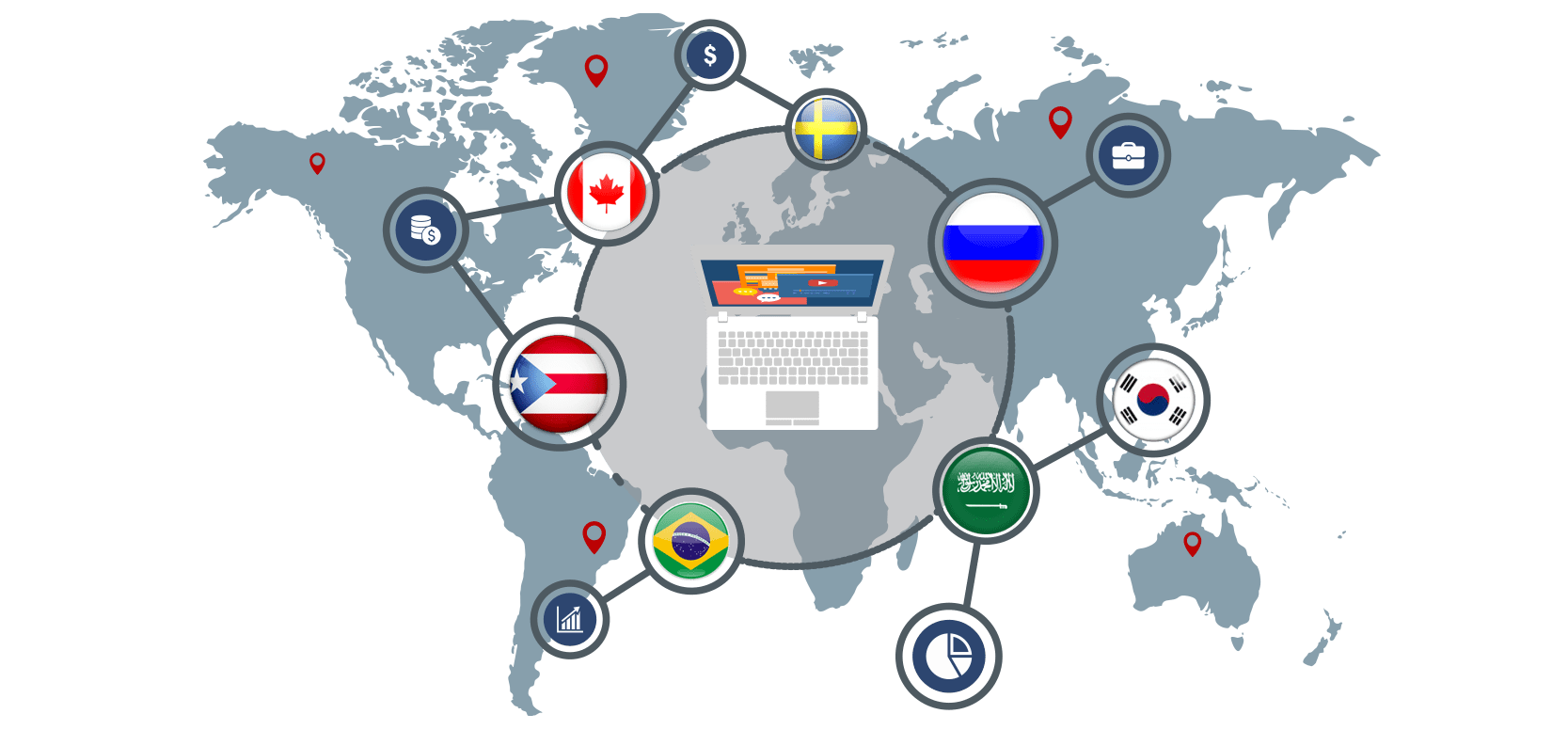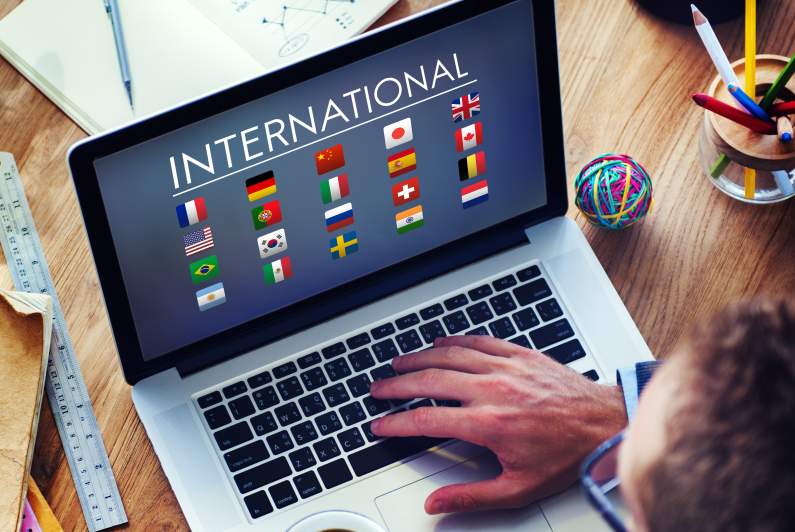
The Internet is global and having a website for international business is essential to becoming a global player these days. Even if you are not considering global expansion, you may want to change your strategy by exploring overseas opportunities. A global website includes many components that should not be taken for granted. Exporters should be aware of these components because some of these components are responsible for exporting, regardless of the web developer’s role in the process. You need to ensure that your website is suitable for customers in your target overseas markets.
.
There are some basic tips that lead to create an international website that attracts different audiences without investment, time and money:
.
1- Reach new audiences with your current website
.
The Internet removes geographical barriers and makes it easier for different industries to access new markets. If you are trying to expand your business, it is highly recommended to make your website international. For example, if you are an online service provider and your website is in English, your service can provide content to consumers in Canada, the United Kingdom, or other English-speaking countries. Make changes to your website, including translation and marketing efforts. Creating one or more landing pages in the target language of your chosen country or region is necessary to generate and increase interest in your products or services.
.
2- Creating a multilingual website
.
If you want to expand into non-English speaking international markets, you should seriously consider translating your website into other languages. According to Wikipedia, 70% of the world’s population doesn’t speak English. A multilingual website is one that is available in multiple languages, and your users can choose their own language. A multilingual CMS (Content Management System) allows you to design the website in multiple languages and allow users to choose the language they want. If your short or long-term goal in expanding your business is to translate your website into other languages, you should invest in a multilingual CMS when you create your website. You can always translate your website later, but if you don’t have multilingual support, there will be a big problem managing the content when you need assistance.
.

.
3- The importance of content translation
.
Poor content translation can hurt your business, brand value, and revenue. Online translators, such as Google Translate, can be set up to automatically translate your entire website. This may seem like a quick and inexpensive solution, but the quality of these translations is poor. This negatively impacts presentation, usability, and potentially your search engine rankings. To ensure that your website content is translated correctly, you should hire a professional translator who speaks and writes the language fluently and understands the context as well as the target market and culture.
.
4- Multi-regional website design
.
The difference between a multilingual and a multiregional website is subtle but important. A multilingual website is one that has content in more than one language (e.g., a website in English and French). A multiregional website specifically targets users in different countries. For example, a version of your website for the US and a version for Canada can offer multilingual support in English and French and currency support for Canadian dollars. A multi-regional website is one that explicitly targets users in different countries. For example, a product manufacturer that ships to both Canada and the United States. A multilingual website, offers content in more than one language. A multi-regional website on the other hand, specifically targets users in certain countries and Offers country-specific products or services and uses different marketing messages to target different populations.
.
Most large international companies have multi-regional websites. Marketing is another aspect of your business that requires both central and local strategies, which in turn affect how you operate your multi-regional websites. For example, should you run the same promotions on all of your regional sites, or would you rather design your campaigns differently for each segment?
Geolocation involves determining the geographic location of a website user based on their IP address. Although IP-based geolocation is not always accurate, it does provide information about the user’s origin (including country, region, city, zip code, latitude, longitude, and time zone). With this information, you can provide the regional version of your website that corresponds to the user’s geographic location. If you have or plan to create a multiregional website, you should be aware of the legal, technical, and administrative requirements that may apply to you
.

.
5- Adding foreign domains
.
If you plan to expand internationally, especially by building multi-regional websites, you should consider registering international domains. Even if this is not part of your short-term plans, be aware that it may be difficult or impossible to obtain your company’s domain name once it is registered abroad. When you think of a domain name, you usually think of “.com”, the most popular domain. There are other domains that you can register regardless of your location (“.net”, “.biz”, “.info”, etc.). These are called generic top-level domains.
A domain name is the physical name of a website, and it is arguably the most important part of your website. Similar to your address or phone number, there cannot be two identical domain names.
.
If your expired domain is acquired by someone else, you will no longer be able to use the domain with Google Workspace and will need to remove it from the account. However, the general rule is that domains can only be renewed for full years, so you can only add 5 years. Each country has its own rules, and in some countries a company must have a local presence, be a registered trustee, or own a trademark before a domain name can be granted. For example, to obtain an Australian domain name (.au), you must be a company registered in Australia or own a trademark registered in Australia. To have a presence in Brazil (.br), you must be an individual or company resident in Brazil, etc. Country-specific domains can also be expensive.
.
Country-specific top-level domain names (ccTDL) are domain names associated with specific countries. For example, .de is for websites targeting Germany, and .Co.Uk is for the United Kingdom. These domains are an effective way to target content or online services to a specific country. First, they are easy for customers to understand and almost self-explanatory. This is mainly due to existing global websites that have already introduced country-specific domains to target customers in specific territories, such as Amazon.co.uk, Amazon.de, etc. In addition, ccTLDs are also adopted by major search engines to improve the ranking of content specific to that region. Therefore, your localized website will be ranked correctly for local search queries.
It is also interesting to note that Google itself has adopted this strategy for the localization of its search engine, offering country-specific domains for each country.
.
6- User interface
.
The user interface (UI) is another powerful tool to improve navigation and customization of localized websites. For example, UI often has small buttons that allow users to switch to their preferred language, currency, etc. The UI also has the task of creating a consistent and friendly environment that allows visitors to browse and traverse the website. An intelligent UI also uses cookies and other technical tools to facilitate this process. For example, UI can store visitors’ local preferences (such as language and currency) for future visits.
.

.
7- The value of website content
.
Good content sets your website apart from the crowd and gets the right message into the hearts and minds of your customers. The success of your website is primarily determined by its content. Ultimately, content makes or breaks your customers’ wallets. All other components of your website (design, visual elements, videos, etc.) play a secondary role. If you have effective slogans, a good design will only increase their effectiveness. Design in and of itself is not a selling tool. Your website content should always start with thorough market research. First, identify your key customers and determine how you want to appeal to them.
Taglines and slogans that are customer-centric (i.e., focused on the customer’s needs and wants) are critical to capturing the attention of your potential customers. Your taglines must contain a clear value proposition and include an effective call to action. The key to a successful website is clear, relevant, keyword-rich content that conveys the right message with power and conviction. The content on your website should appeal to your target audience, engage them and move them to action.
.
8- Hire a copywriter
.
Since good content is so important to the success of your website, you should hire a professional copywriter to create professional copy for your website. Copywriting is the professional writing of content for marketing purposes.
Effective content doesn’t always have to be in the form of text. Videos on websites are changing the way important messages are delivered. Website visitors expect to get the information they need without much effort. Custom videos offer a great way to engage audiences and deliver important messages in a format that requires less effort than reading large amounts of text. In addition, illustrations, infographics, diagrams, and interactive presentations are often used to explain difficult concepts and help users make decisions.
.
9- Effective design strengthens your message
.
“A picture is worth a thousand words” When it comes to web design, this is especially true as first impressions are the most important. Statistics show that your website usually has between one and five seconds to engage your website visitor. That’s barely enough time to read and process a piece of content. This means you need to find additional methods to keep the visitor’s attention or lose them to another website. At this point, the design and appearance of your website is important. It creates the first impression, captures the attention and makes the visitor read and process your keywords, dive into your website and finally make a purchase decision with confidence. Effective design is consistent with your copy; it supports your messages, reinforces them, and conveys them in a visual, easy-to-process way that allows your customers to identify with your website on a deeper level. Good design also strengthens your company’s brand and facilitates buying decisions. Design must work with your branding and content to highlight your strengths and core company values, and ultimately drive users to action.
.

.
10- Use high quality images
.
Nothing complements and represents your business better than professional and original photos of your products, customers, team and facilities. Custom photos set your website apart from others, give it credibility, and create a personal connection with visitors. Using custom photos also provides an opportunity to incorporate your marketing message and brand into the photos. This will greatly increase the marketing power of your website. A great web design is much more than just providing content and making it appealing. Professional web designers must consider all aspects of design, from the color psychology in the target country, to the culture and resolution of the site, to the accessibility and typography requirements to captivate, engage and inspire. Images should be prepared according to the culture, geography, and even events of the target market.
.
11- Simplicity is always better
.
Cultural and language differences in global markets sometimes make prepared content incomprehensible to foreign customers. Usability or user experience, simplicity is your art. Understanding customer behavior will tell you what works and what does not. Basic and proven usability tips include proper use of tags, visual navigation, concise content, and strategic use of images.
Avoid confusing features or functions.
– Are links and buttons clickable as they should be?
– Does the website function properly?
– Is it clear where to find important information?
If not, your website is not designed for usability. Your website should be easy to use and browse, mobile friendly, and easy to find via the most popular search engine listings for your target market. You should leverage your social media tools – such as Facebook, Twitter and blogs – to drive potential customers to your website.
Tailor your SEO strategy to your target area so that potential customers can find you more easily.
